The chef apparel market is projected to grow from USD 836.1 million in 2025 to USD 1,401.3 million in 2035, reflecting a CAGR of 5.3%. The market growth curve exhibits a consistent upward shape, indicating gradual and steady expansion throughout the forecast period. According to FMI’s evidence-based report on product innovation, growth is expected to be primarily driven by rising demand from the hospitality and foodservice sectors from 2025 to 2030. Restaurants, hotels, and catering services are expected to expand their workforce and emphasize uniform quality and functionality. Increasing focus on safety, hygiene, and comfort in professional kitchens is anticipated to further strengthen adoption during this phase.
Between 2030 and 2035, the curve maintains a positive slope, supported by growing awareness of fabric innovation, sustainable materials, and design improvements enhancing durability and comfort. The market will also benefit from customized apparel solutions and brand-oriented uniforms that contribute to professional image and identity. While mature markets in Western Europe may show stable growth, emerging markets in Central and Eastern Europe are likely to accelerate expansion. The curve reflects a smooth trajectory with limited volatility, emphasizing balanced market behavior rather than sharp peaks or slowdowns.
Manufacturing operations reveal fundamental tensions between cost optimization pressures and performance specification requirements that distinguish chef apparel from conventional clothing production. Production facilities coordinate between textile sourcing departments managing flame-resistant fabrics, moisture-wicking materials, and antimicrobial treatments while navigating volatile supply chain costs affected by recent reciprocal tariffs that impose steep charges on apparel imports from major manufacturing regions including China, Vietnam, Bangladesh, and Cambodia. Quality control teams manage dual testing protocols ensuring both garment durability under commercial kitchen conditions and compliance with flammability regulations under Consumer Product Safety Commission standards.
Customer relationship dynamics expose coordination difficulties between hospitality procurement departments managing budget constraints and food service operators demanding specialized performance characteristics including heat resistance, stain protection, and professional appearance standards. Restaurant chains coordinate between corporate purchasing decisions and individual location requirements while managing brand consistency across diverse operational environments. Contract negotiations become complex when balancing volume pricing advantages against customization requirements for logo placement, color specifications, and sizing variations that affect production scheduling and inventory management.
Competitive pressures intensify when companies navigate between maintaining margins under pressure from tariff increases while meeting customer expectations for quality and performance. Market differentiation requires coordination between marketing teams promoting brand values and operations teams delivering consistent product quality and service levels. Technology integration demands coordination between traditional manufacturing processes and emerging customization capabilities including embroidery automation, digital printing, and on-demand production systems.
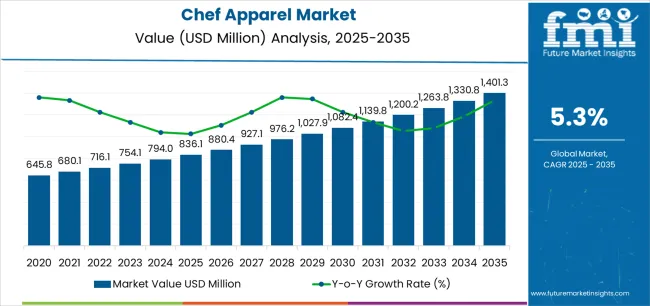
| Period | Primary Revenue Buckets | Share | Notes |
|---|---|---|---|
| Today | Cotton-based chef uniforms (jackets, pants, aprons) | 58% | Traditional materials, established restaurants |
| Polyester blend uniforms | 35% | Easy-care properties, chain operations | |
| Premium specialty fabrics | 7% | High-end establishments, luxury applications | |
| Future (3-5 yrs) | Advanced cotton systems | 45-48% | Enhanced durability, stain resistance |
| High-performance polyester blends | 25-28% | Moisture management, temperature control | |
| Hotel & hospitality applications | 12-15% | Luxury properties, resort operations | |
| High-end restaurant uniforms | 8-12% | Fine dining, celebrity chef establishments | |
| Food processing uniforms | 6-10% | Industrial kitchens, manufacturing facilities | |
| Custom & specialty applications | 4-7% | Branded uniforms, specialty restaurants |
At-a-Glance Metrics
| Metric | Value |
|---|---|
| Market Value (2025) | USD 836.1 million |
| Market Forecast (2035) | USD 1,401.3 million |
| Growth Rate | 5.3% CAGR |
| Leading Material | Cotton-Based Uniforms |
| Primary Application | Hotel & Restaurant Segment |
The market demonstrates strong fundamentals with cotton-based uniform systems capturing a dominant share through advanced fabric properties and commercial application optimization. Hotel and restaurant applications drive primary demand, supported by increasing hygiene requirements and food service industry modernization initiatives. Geographic expansion remains concentrated in developed markets with established hospitality infrastructure, while emerging economies show accelerating adoption rates driven by culinary industry modernization initiatives and rising professional standards.
Design for operational durability, not just appearance
Primary Classification: The market segments by material type into cotton, polyester, and others, representing the evolution from traditional natural fibers to sophisticated synthetic blends for comprehensive culinary uniform optimization.
Secondary Classification: Application segmentation divides the market into hotel, high-end restaurant, food processing, and others, reflecting distinct requirements for uniform performance, durability standards, and professional presentation specifications.
Tertiary Classification: End-use segmentation covers restaurant chains, hotel groups, catering companies, food manufacturers, and culinary schools, while distribution channels span direct sales, uniform distributors, and specialized hospitality suppliers.
Regional Classification: Geographic distribution covers North America, Latin America, Western Europe, Eastern Europe, East Asia, South Asia Pacific, and Middle East & Africa, with developed markets leading adoption while emerging economies show accelerating growth patterns driven by hospitality industry modernization programs.
The segmentation structure reveals material progression from traditional cotton uniforms toward sophisticated synthetic blends with enhanced performance capabilities, while application diversity spans from luxury hotels to industrial food processing requiring precision uniform solutions.
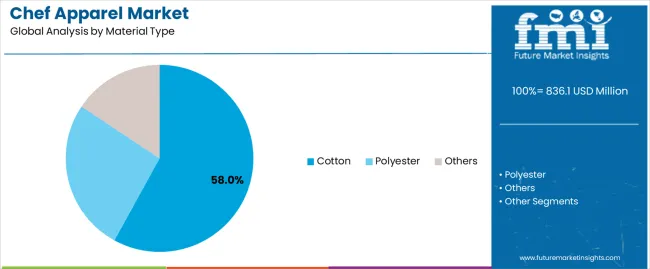
Market Position: Cotton uniform systems command the leading position in the chef apparel market with 58% market share through proven fabric technologies, including breathable construction, natural comfort properties, and professional appearance optimization that enable food service operators to achieve optimal staff presentation across diverse restaurant and hospitality environments.
Value Drivers: The segment benefits from hospitality industry preference for traditional uniform systems that provide natural comfort, professional appearance, and operational durability without requiring synthetic fabric infrastructure. Advanced cotton processing features enable enhanced stain resistance, easy care properties, and integration with existing uniform programs, where comfort performance and professional presentation represent critical operational requirements.
Competitive Advantages: Cotton uniform systems differentiate through proven comfort reliability, natural fabric characteristics, and integration with established uniform management systems that enhance facility effectiveness while maintaining optimal professional standards suitable for diverse culinary applications.
Key market characteristics:
Polyester uniform systems maintain a 35% market position in the chef apparel market due to their performance advantages and easy-care positioning benefits. These materials appeal to facilities requiring efficient uniform solutions with enhanced durability profiles for high-volume operations. Market growth is driven by chain restaurant expansion, emphasizing performance fabric solutions and operational efficiency through optimized care designs.
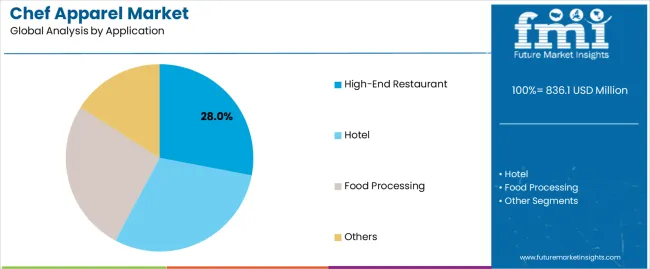
Market Context: Hotel applications demonstrate strong growth in the chef apparel market with 6.8% CAGR due to widespread adoption of professional uniform programs and increasing focus on hospitality excellence, operational cost efficiency, and staff presentation applications that maximize uniform effectiveness while maintaining luxury standards.
Appeal Factors: Hotel operators prioritize uniform reliability, professional consistency, and integration with existing hospitality infrastructure that enables coordinated uniform operations across multiple service departments. The segment benefits from substantial hospitality industry investment and modernization programs that emphasize the acquisition of premium uniforms for staff differentiation and guest experience applications.
Growth Drivers: Hotel expansion programs incorporate chef uniforms as essential components for culinary operations, while luxury hospitality growth increases demand for uniform capabilities that comply with brand standards and minimize operational complexity.
Market Challenges: Varying brand requirements and operational scale complexity may limit uniform standardization across different hotels or service scenarios.
Application dynamics include:
High-end restaurant applications capture 28% market share through specialized presentation requirements in fine dining establishments, celebrity chef restaurants, and culinary applications. These facilities demand premium uniforms capable of supporting brand requirements while providing professional presentation access and operational durability capabilities.
Food processing applications account for 22% market share, including manufacturing facilities, commercial kitchens, and industrial operations requiring performance uniform capabilities for safety optimization and operational effectiveness.
Market Context: Restaurant Chains dominate the market with 6.2% CAGR, reflecting the primary demand source for chef apparel technology in food service applications and operational standardization.
Business Model Advantages: Restaurant Chains provide direct market demand for standardized uniform systems, driving volume production and cost optimization while maintaining quality control and brand consistency requirements.
Operational Benefits: Restaurant Chain applications include brand standardization, cost efficiency, and quality assurance that drive consistent demand for uniform systems while providing access to latest fabric technologies.
| Category | Factor | Impact | Why It Matters |
|---|---|---|---|
| Driver | Hospitality industry growth & restaurant expansion (dining trends, tourism growth) | ★★★★★ | Growing food service market requires professional uniforms with enhanced presentation capabilities and durability properties proven effective across hospitality applications. |
| Driver | Professional standards advancement & hygiene requirements (food safety, brand image) | ★★★★★ | Transforms uniform requirements from "basic clothing" to "professional presentation"; operators that offer quality uniforms and compliance features gain competitive advantage. |
| Driver | Premium dining market growth & culinary excellence (fine dining, celebrity chefs) | ★★★★☆ | Premium restaurants need distinctive, high-quality uniforms; demand for exclusive and superior uniform solutions expanding addressable market. |
| Restraint | Cost pressures & budget constraints (especially for small restaurants) | ★★★★☆ | Smaller restaurant operators defer uniform upgrades; increases price sensitivity and slows premium uniform adoption in cost-conscious markets. |
| Restraint | Alternative uniform options competition (generic workwear, casual alternatives) | ★★★☆☆ | Standard workwear alternatives offer established supply chains and lower costs, potentially limiting chef apparel adoption in traditional applications. |
| Trend | Fabric technology integration & performance enhancement (moisture management, stain resistance) | ★★★★★ | Advanced fabric properties, comfort optimization, and performance analytics transform operations; technology integration and performance enhancement become core value propositions. |
| Trend | Customization & brand-specific solutions (logo integration, color matching) | ★★★★☆ | Custom uniforms for specific brands and applications; specialized designs and targeted branding capabilities drive competition toward customization solutions. |
The chef apparel market demonstrates varied regional dynamics with Growth Leaders including China (7.2% growth rate) and India (6.6% growth rate) driving expansion through hospitality development initiatives and food service industry modernization. Steady Performers encompass Germany (6.1% growth rate), Brazil (5.6% growth rate), and developed regions, benefiting from established hospitality industries and professional uniform adoption. Mature Markets feature United States (5.0% growth rate), United Kingdom (4.5% growth rate), and Japan (4.0% growth rate), where hospitality advancement and brand standardization requirements support consistent growth patterns.
Regional synthesis reveals East Asian markets leading adoption through hospitality expansion and food service development, while North American countries maintain steady expansion supported by uniform technology advancement and professional standardization requirements. European markets show strong growth driven by hospitality applications and quality integration trends.
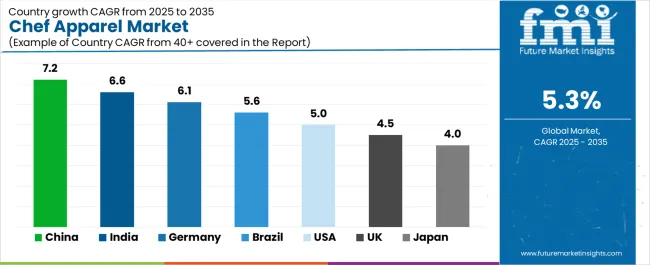
| Region/Country | 2025-2035 Growth | How to win | What to watch out |
|---|---|---|---|
| China | 7.2% | Focus on volume production solutions | Regulatory changes; local competition |
| India | 6.6% | Lead with cost-effective manufacturing | Import restrictions; quality barriers |
| Germany | 6.1% | Provide premium quality uniforms | Over-regulation; lengthy approvals |
| Brazil | 5.6% | Offer value-oriented solutions | Currency fluctuations; import duties |
| United States | 5.0% | Push technology integration | Compliance costs; scaling challenges |
| United Kingdom | 4.5% | Focus on premium applications | Economic impacts; uniform costs |
| Japan | 4.0% | Emphasize quality manufacturing | Traditional preferences; adoption rates |
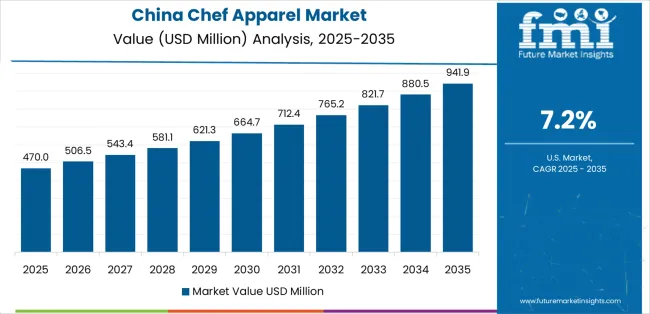
China establishes fastest market growth through aggressive hospitality development programs and comprehensive food service industry expansion, integrating advanced chef uniform systems as standard components in hotel facilities and restaurant installations. The country's 7.2% growth rate reflects government initiatives promoting hospitality infrastructure and domestic uniform capabilities that mandate the use of professional uniform systems in hotel and restaurant facilities. Growth concentrates in major hospitality hubs, including Beijing, Shanghai, and Guangzhou, where hospitality development showcases integrated uniform systems that appeal to restaurant operators seeking professional presentation optimization capabilities and operational applications.
Chinese manufacturers are developing cost-effective uniform solutions that combine domestic production advantages with advanced fabric features, including enhanced durability control and improved comfort capabilities. Distribution channels through hospitality suppliers and uniform distributors expand market access, while government support for hospitality development supports adoption across diverse restaurant and hotel segments.
Strategic Market Indicators:
In Mumbai, Delhi, and Bangalore, hotel facilities and restaurant operators are implementing professional chef uniform systems as standard equipment for staff presentation and operational optimization applications, driven by increasing government hospitality investment and tourism modernization programs that emphasize the importance of professional presentation capabilities. The market holds a 6.6% growth rate, supported by government hospitality initiatives and tourism development programs that promote professional uniform systems for hotel and restaurant facilities. Indian operators are adopting uniform systems that provide consistent professional appearance and comfort features, particularly appealing in urban regions where staff presentation and operational excellence represent critical business requirements.
Market expansion benefits from growing hospitality capabilities and international tourism partnerships that enable domestic production of professional uniform systems for hotel and restaurant applications. Technology adoption follows patterns established in hospitality equipment, where reliability and appearance drive procurement decisions and operational deployment.
Market Intelligence Brief:
Germany's advanced hospitality market demonstrates sophisticated chef uniform deployment with documented presentation effectiveness in hotel applications and restaurant facilities through integration with existing hospitality systems and operational infrastructure. The country leverages engineering expertise in textiles and quality systems integration to maintain a 6.1% growth rate. Hospitality centers, including Bavaria, Baden-Württemberg, and North Rhine-Westphalia, showcase premium installations where uniform systems integrate with comprehensive hospitality platforms and facility management systems to optimize staff presentation and operational effectiveness.
German manufacturers prioritize system quality and EU compliance in uniform development, creating demand for premium systems with advanced features, including facility integration and professional presentation systems. The market benefits from established hospitality infrastructure and a willingness to invest in professional uniform technologies that provide long-term operational benefits and compliance with international hospitality standards.
Market Intelligence Brief:
Brazil's market expansion benefits from diverse hospitality demand, including tourism modernization in Rio de Janeiro and São Paulo, hotel facility upgrades, and government hospitality programs that increasingly incorporate professional uniform solutions for staff applications. The country maintains a 5.6% growth rate, driven by rising tourism activity and increasing recognition of professional uniform benefits, including precise presentation control and enhanced operational effectiveness.
Market dynamics focus on cost-effective uniform solutions that balance professional presentation performance with affordability considerations important to Brazilian hospitality operators. Growing tourism industrialization creates continued demand for modern uniform systems in new hospitality infrastructure and facility modernization projects.
Strategic Market Considerations:
United States establishes market leadership through comprehensive hospitality programs and advanced food service infrastructure development, integrating chef uniform systems across restaurant and hotel applications. The country's 5.0% growth rate reflects established hospitality industry relationships and mature uniform technology adoption that supports widespread use of professional uniform systems in restaurant and hotel facilities. Growth concentrates in major hospitality centers, including California, New York, and Florida, where uniform technology showcases mature deployment that appeals to hospitality operators seeking proven presentation capabilities and operational efficiency applications.
American hospitality providers leverage established distribution networks and comprehensive technical support capabilities, including sizing programs and training support that create customer relationships and operational advantages. The market benefits from mature regulatory standards and hospitality requirements that mandate uniform system use while supporting technology advancement and operational optimization.
Market Intelligence Brief:
United Kingdom's hospitality market demonstrates integrated chef uniform deployment with documented presentation effectiveness in hotel applications and restaurant facilities through integration with existing hospitality systems and operational infrastructure. The country maintains a 4.5% growth rate, supported by hospitality excellence programs and presentation effectiveness requirements that promote professional uniform systems for hospitality applications. Hotel facilities across England, Scotland, and Wales showcase systematic installations where uniform systems integrate with comprehensive hospitality platforms to optimize staff presentation and operational outcomes.
UK hospitality providers prioritize system reliability and industry compatibility in uniform procurement, creating demand for validated systems with proven presentation features, including quality monitoring integration and professional appearance systems. The market benefits from established hospitality infrastructure and excellence requirements that support uniform technology adoption and operational effectiveness.
Market Intelligence Brief:
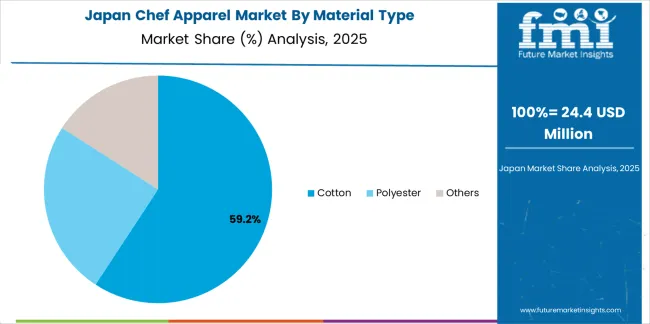
Japan's market growth benefits from precision hospitality demand, including advanced hotel facilities in Tokyo and Osaka, quality integration, and service enhancement programs that increasingly incorporate uniform solutions for presentation applications. The country maintains a 4.0% growth rate, driven by hospitality technology advancement and increasing recognition of precision uniform benefits, including accurate presentation control and enhanced service outcomes.
Market dynamics focus on high-precision uniform solutions that meet Japanese quality standards and presentation effectiveness requirements important to hospitality operators. Advanced hospitality technology adoption creates continued demand for sophisticated uniform systems in hotel facility infrastructure and service modernization projects.
Strategic Market Considerations:
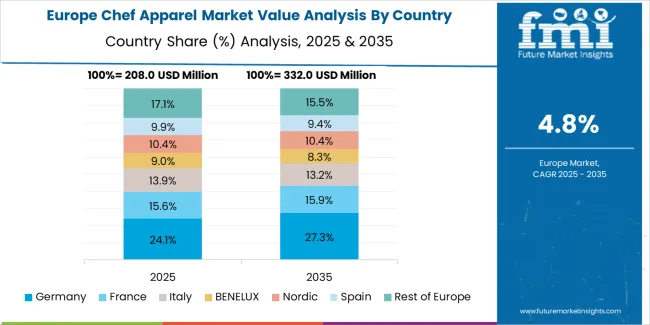
The European chef apparel market is projected to grow from USD 185.4 million in 2025 to USD 312.8 million by 2035, registering a CAGR of 5.4% over the forecast period. Germany is expected to maintain its leadership position with a 38.2% market share in 2025, supported by its advanced hospitality infrastructure and major culinary centers.
United Kingdom follows with a 24.7% share in 2025, driven by comprehensive hospitality programs and culinary excellence development initiatives. France holds a 18.9% share through specialized culinary applications and hospitality compliance requirements. Italy commands a 12.1% share, while Spain accounts for 6.1% in 2025. The rest of Europe region is anticipated to gain momentum, expanding its collective share from 3.8% to 4.2% by 2035, attributed to increasing hospitality adoption in Nordic countries and emerging culinary facilities implementing hospitality modernization programs.
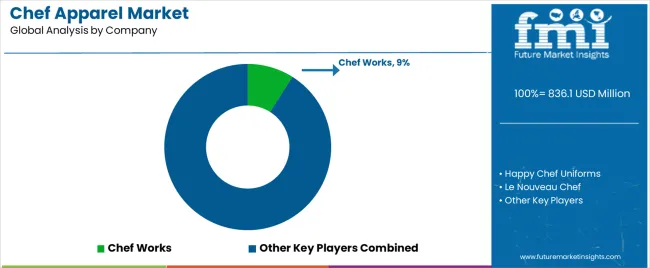
| Stakeholder | What they actually control | Typical strengths | Typical blind spots |
|---|---|---|---|
| Global brands | Distribution reach, broad product catalogs, brand recognition | Wide availability, proven quality, multi-region support | Product refresh cycles; customer dependency on brand validation |
| Technology innovators | Fabric R&D; advanced material technologies; enhanced performance properties | Latest technologies first; attractive ROI on performance effectiveness | Service density outside core regions; scaling complexity |
| Regional specialists | Local compliance, fast delivery, nearby customer support | "Close to customer" support; pragmatic pricing; local regulations | Technology gaps; talent retention in customer service |
| Full-service providers | Uniform programs, sizing services, inventory management | Lowest operational risk; comprehensive support | Service costs if overpromised; technology obsolescence |
| Niche specialists | Specialized applications, custom uniforms, brand services | Win premium applications; flexible configurations | Scalability limitations; narrow market focus |
| Item | Value |
|---|---|
| Quantitative Units | USD 836.1 million |
| Material Type | Cotton, Polyester, Others |
| Application | Hotel, High-End Restaurant, Food Processing, Others |
| End Use | Restaurant Chains, Hotel Groups, Catering Companies, Food Manufacturers, Culinary Schools |
| Regions Covered | North America, Latin America, Western Europe, Eastern Europe, East Asia, South Asia Pacific, Middle East & Africa |
| Countries Covered | China, India, Germany, Brazil, United States, United Kingdom, Japan, Canada, France, Australia, and 25+ additional countries |
| Key Companies Profiled | Chef Works, Happy Chef Uniforms, Le Nouveau Chef, Red Kap, Clement Design USA, Newchef Fashion, Fabian Group, Cookman USA, and Birkenstock |
| Additional Attributes | Dollar sales by material type and application categories, regional adoption trends across East Asia, North America, and Western Europe, competitive landscape with textile manufacturers and uniform suppliers, hospitality operator preferences for uniform effectiveness and professional presentation, integration with hospitality platforms and inventory management systems, innovations in fabric technology and uniform enhancement, and development of advanced uniform solutions with enhanced performance and operational optimization capabilities. |
The global chef apparel market is estimated to be valued at USD 836.1 million in 2025.
The market size for the chef apparel market is projected to reach USD 1,401.3 million by 2035.
The chef apparel market is expected to grow at a 5.3% CAGR between 2025 and 2035.
The key product types in chef apparel market are cotton, polyester and others.
In terms of application, high-end restaurant segment to command 28.0% share in the chef apparel market in 2025.






Our Research Products

The "Full Research Suite" delivers actionable market intel, deep dives on markets or technologies, so clients act faster, cut risk, and unlock growth.

The Leaderboard benchmarks and ranks top vendors, classifying them as Established Leaders, Leading Challengers, or Disruptors & Challengers.

Locates where complements amplify value and substitutes erode it, forecasting net impact by horizon

We deliver granular, decision-grade intel: market sizing, 5-year forecasts, pricing, adoption, usage, revenue, and operational KPIs—plus competitor tracking, regulation, and value chains—across 60 countries broadly.

Spot the shifts before they hit your P&L. We track inflection points, adoption curves, pricing moves, and ecosystem plays to show where demand is heading, why it is changing, and what to do next across high-growth markets and disruptive tech

Real-time reads of user behavior. We track shifting priorities, perceptions of today’s and next-gen services, and provider experience, then pace how fast tech moves from trial to adoption, blending buyer, consumer, and channel inputs with social signals (#WhySwitch, #UX).

Partner with our analyst team to build a custom report designed around your business priorities. From analysing market trends to assessing competitors or crafting bespoke datasets, we tailor insights to your needs.
Supplier Intelligence
Discovery & Profiling
Capacity & Footprint
Performance & Risk
Compliance & Governance
Commercial Readiness
Who Supplies Whom
Scorecards & Shortlists
Playbooks & Docs
Category Intelligence
Definition & Scope
Demand & Use Cases
Cost Drivers
Market Structure
Supply Chain Map
Trade & Policy
Operating Norms
Deliverables
Buyer Intelligence
Account Basics
Spend & Scope
Procurement Model
Vendor Requirements
Terms & Policies
Entry Strategy
Pain Points & Triggers
Outputs
Pricing Analysis
Benchmarks
Trends
Should-Cost
Indexation
Landed Cost
Commercial Terms
Deliverables
Brand Analysis
Positioning & Value Prop
Share & Presence
Customer Evidence
Go-to-Market
Digital & Reputation
Compliance & Trust
KPIs & Gaps
Outputs
Full Research Suite comprises of:
Market outlook & trends analysis
Interviews & case studies
Strategic recommendations
Vendor profiles & capabilities analysis
5-year forecasts
8 regions and 60+ country-level data splits
Market segment data splits
12 months of continuous data updates
DELIVERED AS:
PDF EXCEL ONLINE
Apparel Market Size and Share Forecast Outlook 2025 to 2035
Apparel Re-commerce Market Size and Share Forecast Outlook 2025 to 2035
Chef Bases Market
Gym Apparel Market Size and Share Forecast Outlook 2025 to 2035
Pet Apparel Market Analysis - Size, Demand & Forecast 2025 to 2035
Kids Apparel Market Trends - Growth, Demand & Forecast 2025 to 2035
Rugby Apparel Market Forecast and Outlook 2025 to 2035
Blank Apparel Market – Growth & Demand Forecast 2025 to 2035
Bamboo Apparel Market Size and Share Forecast Outlook 2025 to 2035
Outdoor Apparel and Accessories Market Size and Share Forecast Outlook 2025 to 2035
Sequins Apparel Market Size and Share Forecast Outlook 2025 to 2035
TIC For Apparel Market
Crossfit Apparel Market Size and Share Forecast Outlook 2025 to 2035
Maternity Apparel Market Size and Share Forecast Outlook 2025 to 2035
Decorated Apparel Market segmented by Product, End-user and Distribution Channel through 2025 to 2035
Market Share Distribution Among Maternity Apparel Providers
Equestrian Apparel Market Size and Share Forecast Outlook 2025 to 2035
Secondhand Apparel Market Analysis - Size, Share, and Forecast 2025 to 2035
Competitive Overview of Secondhand Apparel Market Share
Second-hand Apparel Market in Europe Analysis - Size, Share, and Forecast Outlook 2025 to 2035

Thank you!
You will receive an email from our Business Development Manager. Please be sure to check your SPAM/JUNK folder too.
Chat With
MaRIA